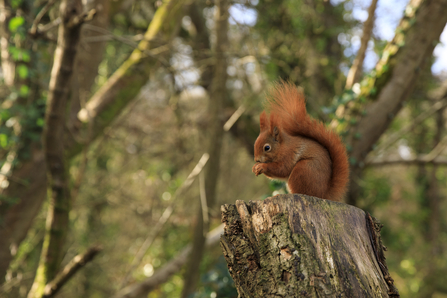As summer draws to a close, days become shorter, temperatures become cooler, and seasonal showers roll across the landscape. Autumn is a truly magical season for habitats and wildlife; this is encapsulated by the transformation of our ancient woodlands, including those found at Hampshire and Isle of Wight Wildlife Trust nature reserves, such as Pamber Forest near Basingstoke. As they die, leaves once green take on fiery shades of yellow, orange, and red and carpet the forest floor in a dense mosaic of colour.
Ancient woodland in autumn
Woodland and Leaves © Jane Page
Making up just 2.5% of the UK’s land surface, our ancient woodlands are irreplaceable. Centuries of undisturbed soils and the decay of natural matter has created the ideal location for complex communities of plants, fungi, and rare species. Ancient woodlands also hold 37% of all carbon stored in trees, which makes them crucial to the UK's climate change effort. Teeming with wildlife and shrouded in mystery, it is easy to recognise why these places are home to so many myths, legends, and folk tales.
Walking through an ancient woodland in Autumn, you are likely to see clusters of mushrooms and toadstools decorating the bases of ancient trees. In particular, look out for Chicken of the Woods (a yellow fungi, usually found growing on ancient oak trees which makes a scrumptious alternative to chicken in things like curries). Please remember, however, that fungi also include some of our most poisonous species and you should NEVER eat any fungi you find unless you are 100% certain about their identity.
These areas become hives of activity in autumn. Creatures such as hedgehogs, dormice, bats, and badgers hurriedly stockpile food and build up fat deposits as they prepare for the coming Winter. This means that autumn is the best season to spot some of your favourite creatures, including rare native species such as red squirrels.

Red Squirrel © Sian Addison
Autumn is one of the busiest times of the year for red squirrels, with nuts and berries ready for picking. With their distinctive russet auburn fur, bushy tail and tufted ears, red squirrels are beautiful to behold. Native to the UK, this once common species has largely disappeared from huge areas of the country.
The trigger for this was the introduction of the North American Grey Squirrel in the 1870’s. The aggressive grey squirrel outcompetes the red for food and carries a deadly disease known as the squirrel pox virus. Separated from mainland England by the Solent, the Isle of Wight has become a stronghold for England’s threatened red squirrel population. Autumn is the ideal time to spot red squirrels in the fractured ancient woodlands of the island, as they hurriedly stash nuts and seeds ready for Winter.
Written by Communications Champion, Kai Rasmussen.

